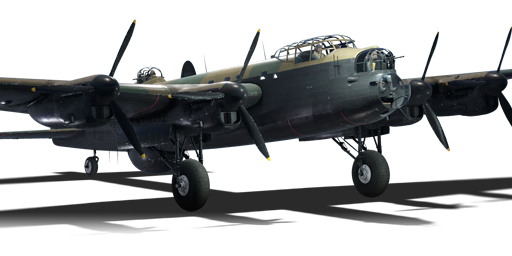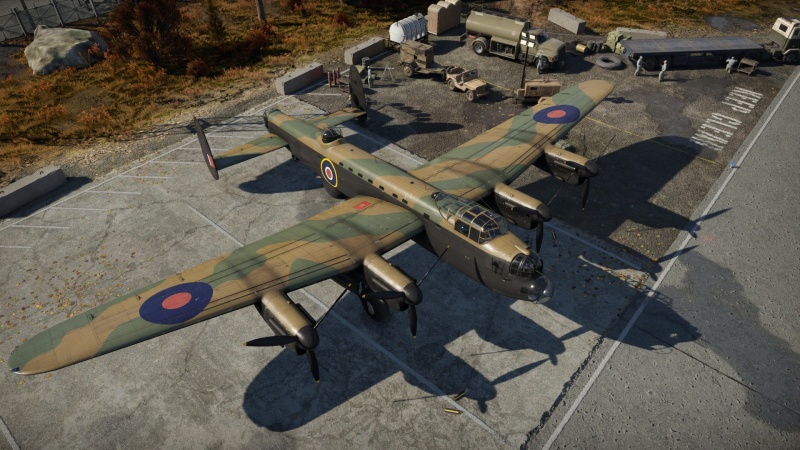Lancaster B Mk I
| This page is about the British heavy bomber Lancaster B Mk I. For the other version, see Lancaster B Mk III. |
Contents
Description
The Lancaster B Mk I is a rank IV British bomber with a battle rating of 5.0 (AB), 5.3 (RB), and 5.7 (SB). It was introduced in Update 1.43.
The Avro Lancaster B Mk. I is a long-range heavy bomber optimised for destroying stationary targets such as pillboxes, bases, and airfields with bombs from high altitude.
General info
Flight performance
| Characteristics | Max Speed (km/h at 3,048 m) |
Max altitude (metres) |
Turn time (seconds) |
Rate of climb (metres/second) |
Take-off run (metres) | |||
|---|---|---|---|---|---|---|---|---|
| AB | RB | AB | RB | AB | RB | |||
| Stock | 437 | 423 | 7800 | 43.2 | 44.4 | 7.0 | 6.8 | 750 |
| Upgraded | 465 | 451 | 40.9 | 42.0 | 10.4 | 8.6 | ||
Details
| Features | ||||
|---|---|---|---|---|
| Combat flaps | Take-off flaps | Landing flaps | Air brakes | Arrestor gear |
| ✓ | ✓ | ✓ | X | X |
| Limits | ||||||
|---|---|---|---|---|---|---|
| Wings (km/h) | Gear (km/h) | Flaps (km/h) | Max Static G | |||
| Combat | Take-off | Landing | + | - | ||
| 0 | 338 | 440 | 338 | 282 | ~4 | ~3 |
| Optimal velocities (km/h) | |||
|---|---|---|---|
| Ailerons | Rudder | Elevators | Radiator |
| < 400 | < 350 | < 350 | > 350 |
| Compressor (RB/SB) | ||
|---|---|---|
| Setting 1 | ||
| Optimal altitude | 100% Engine power | WEP Engine power |
| 1,500 m | 1,400 hp | N/A |
| Setting 2 | ||
| Optimal altitude | 100% Engine power | WEP Engine power |
| 3,600 m | 1,305 hp | 1,398 hp |
Survivability and armour
- 8 mm Steel plate on each pilot's headrest.
- 6.35 mm Steel plate behind each engine.
Modifications and economy
Armaments
Suspended armament
The Lancaster B Mk I can be outfitted with the following ordnance:
- 14 x 250 lb G.P. 250 lb Mk.IV bombs (3,500 lb total)
- 6 x 500 lb G.P. 500 lb Mk.IV bombs + 8 x 250 lb G.P. 250 lb Mk.IV bombs (5,000 lb total)
- 14 x 500 lb G.P. 500 lb Mk.IV bombs (7,000 lb total)
- 1 x 1,000 lb G.P. 1,000 lb Mk.I bomb + 6 x 500 lb G.P. 500 lb Mk.IV bombs + 2 x 250 lb G.P. 250 lb Mk.IV bombs (4,500 lb total)
- 6 x 1,000 lb G.P. 1,000 lb Mk.I bombs + 3 x 250 lb G.P. 250 lb Mk.IV bombs (6,750 lb total)
- 14 x 1,000 lb M.C. 1,000 lb Mk.I bombs (14,000 lb total)
- 1 x 4,000 lb H.C. 4,000 lb Mk.II bomb + 6 x 1,000 lb M.C. 1,000 lb Mk.I bombs + 2 x 250 lb G.P. 250 lb Mk.IV bombs (10,500 lb total)
- 2 x 4,000 lb H.C. 4,000 lb Mk.II bombs (8,000 lb total)
Defensive armament
The Lancaster B Mk I is defended by:
- 2 x 7.7 mm Browning .303 machine guns, nose turret (1,000 rpg = 2,000 total)
- 2 x 7.7 mm Browning .303 machine guns, dorsal turret (1,000 rpg = 2,000 total)
- 4 x 7.7 mm Browning .303 machine guns, tail turret (2,500 rpg = 10,000 total)
Usage in battles
The Lancaster carries the heaviest bomb load of any bomber before the American Boeing B-29 Superfortress, at a fantastic 14,000 lb (6,363 kg), and the heaviest of any British bomber in the game. It can quickly end games if left to go about its business. The Lancaster also has relatively good performance and agility for a four-engined heavy bomber, significantly better than both the American B-17 and B-24 bombers.
Unfortunately, the Lancaster is extremely vulnerable if intercepted by enemy fighters. Its defensive armament consists only of .303 in Browning machine guns; while they have a high rate-of-fire, they are not very lethal to enemy fighters outside of a lucky fire set by the incendiary bullets. In addition, the Lancaster has no ventral turret covering attacks from below due to H2S radar unit (a useless feature in the game). The aircraft itself is not very durable as well and is extremely vulnerable to cannons of 20 mm calibre and larger.
Manual Engine Control
| MEC elements | ||||||
|---|---|---|---|---|---|---|
| Mixer | Pitch | Radiator | Supercharger | Turbocharger | ||
| Oil | Water | Type | ||||
| Not controllable | Controllable Not auto controlled |
Controllable Auto control available |
Controllable Auto control available |
Separate | Controllable 2 gears |
Not controllable |
Pros and cons
Pros:
- Massive bombload
- Powerful Merlin engines providing good performance
- Excellent handling and manoeuvrability
Cons:
- Very low durability
- Pathetic defensive armament
- Easily damaged elevators and tail controls
History
Describe the history of the creation and combat usage of the aircraft in more detail than in the introduction. If the historical reference turns out to be too long, take it to a separate article, taking a link to the article about the vehicle and adding a block "/ History" (example: https://wiki.warthunder.com/(Vehicle-name)/History) and add a link to it here using the main template. Be sure to reference text and sources by using <ref></ref>, as well as adding them at the end of the article with <references />. This section may also include the vehicle's dev blog entry (if applicable) and the in-game encyclopedia description (under === In-game description ===, also if applicable).
The Lancaster first Lancasters were built and designed by A.V.Roe and Company (or Avro) as a long-range heavy bomber. It was developed as an "upgrade" from the Avro Manchester which was disliked by crews for its difficulty to fly and underpowered engines.
The Lancaster was designed by Roy Chadwick and first flew on 9th January 1941; entering service in 1942. It was produced by Avro, Armstrong Whitworth, Austin Motors, Metropolitan-Vickers, Vickers Armstrong and Victory Aircraft (for the RCAF)
The Lancaster's long, unobstructed bomb bay enabled it to carry the largest bombs the RAF used (including, 4000, 8000, 12,000 and - when modified - 22,000lb bombs). Because of this, it soon became the most widely used British bomber of the 2nd World War.
No. 617 squadron famously used modified Lancasters during Operation Chastise in raids dams in the Ruhr Valley using Barnes Wallace's Upkeep Mine (or "Bouncing Bomb" as it became known as). This gave 617 squadron the nickname "The Dambusters", sparking the creation of a film by the same name.
In-game description
With RAF Bomber Command's focus being centred on the strategic bombing campaign against German industry, the RAF desperately required a force of heavy bombers to increase the capability provided by their medium bomber fleet. A twin engine Avro Manchester bomber was converted to be powered by four engines and first flown in January 1941. This and subsequent prototypes were deemed to be so successful that the first production variant of the new bomber, now named the Lancaster, was flown in October 1941.
Powered by four Rolls Royce Merlin XX engines rated at 1280 hp, (later upgraded to Merlin 22 or 24s) the Lancaster B.I was capable of reaching speeds of up to 275 mph. With a standard fuel load it could carry 10,000 lbs of bombs over 1000 miles. The maximum ordinance capacity of the Lancaster was one of the highest of any heavy bomber in World War II: 14,000 lb (6,356 kg). Besides standard bombs, the aircraft could carry an 8,000 lb (3,632 kg) "blockbuster" or two 4,000 lb (1,816 kg) high-explosive "cookie" bombs. Special modifications of the bomber could carry even larger bombs, such as the 22,000 lb 'Grand Slam' bomb. For defence, the Lancaster had eight 0.303 inch Colt-Browning Mk.II machine guns located in three turrets: two guns were located in the nose, two in the dorsal turret, and four in the tail turret. This defensive armament was considerably lighter than that of the Lancaster's US counterparts; it relied on darkness for protection rather than firepower. However, even though on paper the Lancaster was an impressive strategic asset, it still had its weaknesses: whereas the Halifax and Stirling could both claim a crew survival rate of 25% in the event of destruction, the Lancaster could only claim a survival rate of 15% for its crews. 58% of all RAF Lancasters were destroyed in combat; a higher loss percentage than any other British aircraft during the entire war.
The Lancaster was first used operationally in March 1942 by No. 44 Squadron. It soon became the backbone of RAF Bomber Command's offensive against the heart of Germany, but was also used against targets all across occupied Europe. The majority of Lancaster operations took place at night due to RAF Bomber Command's policy of night bombing whilst the bombers of the United States Army Air Force tackled targets by day. The Lancaster became legendary on the night of May 17th 1943 when bombers of No 617 Squadron breached the Mohne and Eder dams in Germany with Barnes Wallis' genius 'bouncing bomb'. Lancasters of Nos 9 and 617 Squadrons also sank the German battleship 'Tirpitz' with 12,000 lb 'Tallboy' bombs, also designed by Wallis.
Over 3400 Lancaster B.Is were manufactured between November 1941 and March 1946, making it the most numerous of the Avro Lancaster variants. In addition to RAF operations, the Lancaster was also used by the RAAF and RCAF.
Media
Excellent additions to the article would be video guides, screenshots from the game, and photos.
See also
Links to the articles on the War Thunder Wiki that you think will be useful for the reader, for example:
- reference to the series of the aircraft;
- links to approximate analogues of other nations and research trees.
External links
Paste links to sources and external resources, such as:
- Video on "Grand Slam" bomb (History section) https://www.youtube.com/watch?v=R-Mm-zFW_nA&feature=relmfu
- Lancaster "Data Card" (History section) click here
- Heavy Bombs (History Section) https://www.iwm.org.uk/collections/item/object/205210816
- General Information (History Section) https://books.google.co.uk/books?id=0SkDAAAAMBAJ&pg=PA48-IA3&redir_esc=y#v=onepage&q&f=false
- topic on the official game forum;
- encyclopedia page on the aircraft;
- other literature.
| Avro Aircraft | |
|---|---|
| Bombers | Lancaster B Mk I · Lancaster B Mk III · Lincoln B Mk II · Shackleton MR.Mk.2 |
| Export/Licensed | Lancaster MR.7 |
| Britain bombers | |
|---|---|
| Torpedo | Swordfish Mk I · Swordfish Mk II · ▄Avenger Mk II |
| Dive | V-156-B1 |
| Hydroplanes | ▄Catalina Mk IIIa · Sunderland Mk IIIa · Sunderland Mk V |
| Light | Blenheim Mk IV · Beaufort Mk VIII · ▄Hudson Mk V · Brigand B 1 |
| Based on A20 | ▄Havoc Mk I · ▄Boston Mk I · ▄DB-7 |
| Hampden | Hampden Mk I · Hampden TB Mk I |
| Wellington | Wellington Mk Ic · Wellington Mk Ic/L · Wellington Mk III · Wellington Mk X |
| Halifax | Halifax B Mk IIIa |
| Stirling | Stirling B Mk I · Stirling B Mk III |
| Lancaster | Lancaster B Mk I · Lancaster B Mk III |
| Lincoln | Lincoln B Mk II |
| Shackleton | Shackleton MR.Mk.2 |





